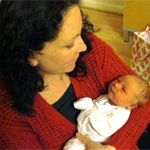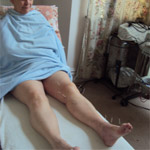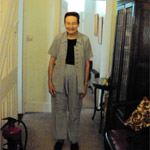Painful periods – don’t just go with the flow
Most women and girls routinely experience at least some discomfort during the first couple of days of their period.
These menstrual cramps are also known in medical circles as Primary Dysmenorrhoea, (from the Greek meaning ‘difficult monthly flow’) and are generally manageable. But for some, the pain is so crippling that it results in one or more days off work or school, poor exam performance, cancelled activities and a reduced quality of life for several days each month.
Period pain is thought to be the result of raised levels of Prostaglandin F2X, a hormone that causes the womb to contract and shed its lining. This action compresses the uterine blood vessels and temporarily cuts off the supply of blood – and hence oxygen – to the womb. Pain triggering chemicals are then released, causing cramps and pain which can be felt as intense spasms or a dull, constant ache. The pain is often at its worst when the bleeding is heaviest, around 48-72 hours into the period.
The severity of pain and common symptoms, such as headache, fatigue, nausea, upset stomach and pains in the back and thighs as well as the stomach, can vary with each period. Sometimes there’s very little discomfort at all, while at other times you can be doubled up!
Self-help
Most period pain can be alleviated by home remedies and minor lifestyle changes such as:
- Heat: Try a heating pad or hot water bottle on your abdomen or soak in a warm aromatherapy bath.
- Relaxation: Stress can worsen period pain so you could try meditation or relaxation exercises.
- Massage: A gentle stomach and back massage can help.
- Exercise: Gentle physical activity, particularly yoga, can ease menstrual pain by relaxing the muscles and improving blood flow to the pelvic area.
- Hang loose: Wear loose-fitting clothes just before and during your period for greater comfort.
- Pain relief: Over-the-counter painkillers specifically designed to relieve period symptoms are easily available from your local pharmacy.
- Quit smoking: Smoking can reduce the supply of oxygen to the pelvic area and make pain worse.
- Eat healthily: Include plenty of high-fibre foods, fruit and vegetables, have less salt (to reduce water retention) and sugar.To help maintain hormonal balance a supplement containing gamma linolenic acid (GLA) such as evening primrose oil or starflower oil also may help, as could Vitamin B6 or magnesium supplements. Do check with your doctor or pharmacist first.
Osteopathy and acupuncture
Many women do not like taking strong painkillers for Primary Dysmenorrhoea every month and both osteopathy and acupuncture are a safe and natural alternative treatment. Osteopathy can help improve blood flow to the uterus, relieve pelvic congestion and ensure the correct balance between the nervous system and pelvic organs. Acupuncture has been used to treat painful periods for centuries but new research has shown that it can ‘significantly’ reduce period pain by at least 50% for up to a year.
What our clients think
“Denise is very supportive and knowledgeable. I have suffered from severe premenstrual and menstrual pain since I was fourteen years old, I am now forty. After attending Denise for acupuncture treatment the pain is minimal. Thank you Denise!!” Alison Gardiner
If you have any of the symptoms outlined above, why not get in touch? We’ll take a look, discuss treatment options with you and start helping to ease your painful periods.





















